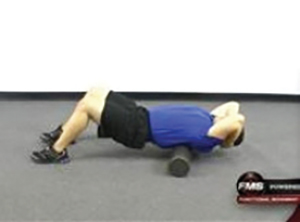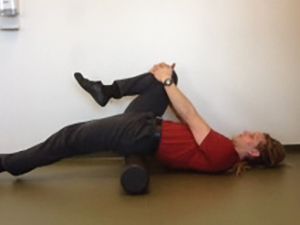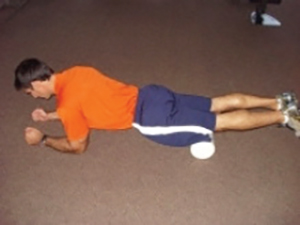
Have you ever felt tightness in your body after sitting at the computer for hours, holding a cell phone between your ear and shoulder, or after a long drive in the car? Knots are usually a type of spasm that causes a small portion of a muscle to tense up and can often be painful. Muscle knots, also called trigger points or myofascial pain, typically occur in calf muscles, lower and mid-back, neck, shins and shoulders but can develop anywhere in the body where muscle or fascia are present. Fascia is strong, stretchy connective tissue that covers, separates and/or holds together different organs, muscles, blood vessels and nerves.
Muscle knots typically feel like a knot or hardened bundle that you feel in the muscle, or pain or tenderness when touching the affected area, or referred pain in nearby muscles, and can cause decreased range of motion and muscle twitching.
Muscle knots and fascial restrictions can occur for a variety of reasons including poor posture, stress, anxiety and dehydration as well as repetitive motion and overuse of a muscle. Fascia is naturally very flexible, but at times can become tight and rigid with injury or stress and is no longer properly moving. When fascia gets tight and becomes a “knot,” one may experience stiffness, achiness, soreness, tenderness and general pain near the muscles. These restrictions and tightness in fascia and connective tissues can restrict the body’s movement, flexibility and function. They may cause muscular shortness and tightness, which can cause pain by putting tension on muscles and joints. A lifestyle of too little movement or repetitive movement that overworks an area of the body can also lead to fascial restrictions. When the fascia dries up and tightens around muscles, it can limit mobility and cause painful knots to develop.
Treatment for muscle knots generally include stretching, exercise, myofascial release technique, heat or cold therapy, dry needling and trigger point injections, and physical therapy.
Why is stretching important?
Stretching muscles in a daily routine is important because it keeps the muscles flexible, strong and healthy. Flexibility is needed to maintain normal range of motion in the joints, and without it, the muscles will shorten and become tight. In addition, when you call on the muscles for activity, if they are not flexible, they will be weak and unable to extend all the way.
How do I loosen fascia and muscles of the back and legs?
There are many ways to stretch and release fascia, but one way to perform myofascial releases is using a foam roller to help with the stretching and release of tight muscles and fascia. The following are some suggestions of stretches that can be done with the foam roller. If one doesn’t have a foam roller, similar stretches and release of fascia can be done with tennis or lacrosse balls or a frozen water bottle.
Thoracic Foam Roller
Begin the exercise lying on your back with the foam roller under your mid-back with hands supporting neck and both legs supporting body weight. Next, roll the mid-back across the foam roller from high to low. You may allow the upper back to bend or fold around the foam roller while maintaining your hip height to promote greater thoracic spine mobility (extension). Never perform exercise to the point of pain.
Hip Flexor Stretch Supine On Foam Roller
Image depicts stretching the right side hip flexors (iliopsoas, tensor fascia latae and sartorius).
Setup:
- Lie on your back
- Bridge up and place the foam roller under your pelvis perpendicular to your trunk
- Bring your right thigh up toward your chest and hold it there with your arms
Action:
- Straighten your left leg allowing it to fall to the ground
- To intensify the stretch, actively push your left heel into the ground with the left knee straight and hold for 30 seconds
- Then perform same exercise with other side

Self MFR Hamstring + Foam Roller
Sit on the floor with the involved thigh over the foam roll. Start by taking 5-10 rolls up and down the hamstring to find areas of tightness and/or tenderness. Pin those areas of tightness on the foam roller as you shift side-to-side to create some shear on the soft tissue. Repeat to all the areas of tightness/tenderness.

IT Band Foam Roller
Lay on your side with the foam roller under your thigh supporting your upper body. Roll up and down on the roller with your weight on the roller.

Foam Roller – Quadriceps
Lie face down in a push-up position with the forearms bent and position the foam roller just above the knee caps. Using your upper body, roll your thighs back and forth over the roller, holding on tender spots for up to 10 seconds until the soreness subsides. For more compression, cross one leg over the over while rolling.

How can physical therapy help at Prime Orthopedic Rehabilitation?
At times the fascia can be difficult to release on your own. Here at Prime Orthopedic Rehabilitation, we believe in manual therapy to mobilize fascia and re-education of the muscles and joints. We will evaluate each patient and figure out where the source of the dysfunction is stemming from. We focus on improving mobility of tissues and joints and restoring function of the patient so they can return to performing activities of daily living.
If you have an issue that isn’t resolving, call Prime Orthopedic Rehabilitation for an appointment at (201) 503-7173.
Jessica Lowy, DPT, CMTPT, DN, Mckenzie A-D, Advanced Schroth Therapist and Michal Porath, MPT, Mckenzie A-D, Advanced Schroth Therapist are owners of Prime Orthopedic Rehabilitation in Tenafly, NJ. They treat necks and backs in their clinic, in addition to general orthopedic and post surgical patients. Call (201) 503-7173 for an appointment.








